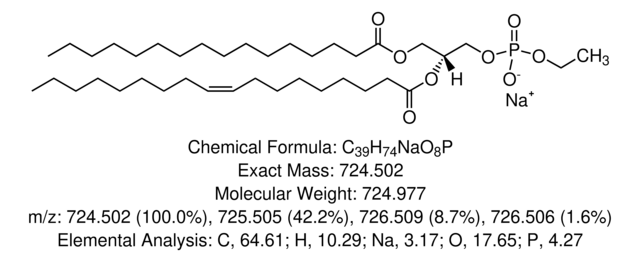Kluczowe dokumenty
860399C
Avanti
16:0-d31-18:1 PC
1-palmitoyl-d31-2-oleoyl-sn-glycero-3-phosphocholine, chloroform
Synonim(y):
110918
About This Item
Polecane produkty
Próba
>99% (TLC)
Postać
liquid
opakowanie
pkg of 1 × 1 mL (860399C-10mg)
pkg of 1 × 2.5 mL (860399C-25mg)
pkg of 1 × 4 mL (860399C-100mg)
producent / nazwa handlowa
Avanti Research™ - A Croda Brand 860399C
stężenie
10 mg/mL (860399C-10mg)
10 mg/mL (860399C-25mg)
25 mg/mL (860399C-100mg)
Warunki transportu
dry ice
temp. przechowywania
−20°C
ciąg SMILES
[H][C@@](COP([O-])(OCC[N+](C)(C)C)=O)(OC(CCCCCCC/C=C\CCCCCCCC)=O)COC(C([2H])([2H])C([2H])([2H])C([2H])([2H])C([2H])([2H])C([2H])([2H])C([2H])([2H])C([2H])([2H])C([2H])([2H])C([2H])([2H])C([2H])([2H])C([2H])([2H])C([2H])([2H])C([2H])([2H])C([2H])([2H])C([2
InChI
1S/C42H82NO8P/c1-6-8-10-12-14-16-18-20-21-23-25-27-29-31-33-35-42(45)51-40(39-50-52(46,47)49-37-36-43(3,4)5)38-48-41(44)34-32-30-28-26-24-22-19-17-15-13-11-9-7-2/h20-21,40H,6-19,22-39H2,1-5H3/b21-20-/t40-/m1/s1/i2D3,7D2,9D2,11D2,13D2,15D2,17D2,19D2,22D2,24D2,26D2,28D2,30D2,32D2,34D2
Klucz InChI
WTJKGGKOPKCXLL-KHCKXXADSA-N
Opis ogólny
Zastosowanie
Opakowanie
Informacje prawne
Hasło ostrzegawcze
Danger
Zwroty wskazujące rodzaj zagrożenia
Zwroty wskazujące środki ostrożności
Klasyfikacja zagrożeń
Acute Tox. 3 Inhalation - Acute Tox. 4 Oral - Carc. 2 - Eye Irrit. 2 - Repr. 2 - Skin Irrit. 2 - STOT RE 1 Oral - STOT SE 3
Organy docelowe
Central nervous system, Liver,Kidney
Kod klasy składowania
6.1D - Non-combustible acute toxic Cat.3 / toxic hazardous materials or hazardous materials causing chronic effects
Klasa zagrożenia wodnego (WGK)
WGK 3
Temperatura zapłonu (°F)
does not flash
Temperatura zapłonu (°C)
does not flash
Certyfikaty analizy (CoA)
Poszukaj Certyfikaty analizy (CoA), wpisując numer partii/serii produktów. Numery serii i partii można znaleźć na etykiecie produktu po słowach „seria” lub „partia”.
Masz już ten produkt?
Dokumenty związane z niedawno zakupionymi produktami zostały zamieszczone w Bibliotece dokumentów.
Nasz zespół naukowców ma doświadczenie we wszystkich obszarach badań, w tym w naukach przyrodniczych, materiałoznawstwie, syntezie chemicznej, chromatografii, analityce i wielu innych dziedzinach.
Skontaktuj się z zespołem ds. pomocy technicznej



![16:0-d31-18:1 PG 1-palmitoyl-d31-2-oleoyl-sn-glycero-3-[phospho-rac-(1-glycerol)] (sodium salt), powder](/deepweb/assets/sigmaaldrich/product/structures/297/771/8d8f499b-6d07-4652-89b1-2803c4be588e/640/8d8f499b-6d07-4652-89b1-2803c4be588e.png)






